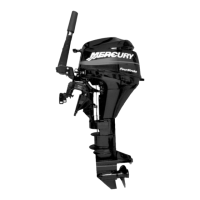16
90-10185R30
GB
gog57
8
7
og
OPERATION
off20
STARTING THE ENGINE - TILLER HANDLE MODELS
Note: Electric starting outboards must have the battery cables connected to a
battery at all times when the engine is running. Even if started manually, as
damage to the charging system could result.
7 Manual Starting Models - Pull the starter rope slowly until you feel the starter
engage, then pull rapidly to crank the engine. Allow rope to return slowly.
Repeat until engine starts.
8 Electric Starting Models - Push starter button and crank the engine. Release
button when engine starts. Do not operate starter motor continuously for longer
than ten seconds at a time. If engine fails to start, wait 30 seconds and try again.
Note: Engine Flooded - If engine will not start, advance the throttle grip to fast
throttle speed. Push in the choke knob and retry starting the engine. After engine
has started, immediately reduce throttle speed to idle.
WARNING
RAPID ACCELERATION HAZARD - Before shifting your outboard from
neutral into gear, decrease engine speed to slow. This will prevent a rapid
acceleration that can cause people in the boat to be thrown from their
seats or out of the boat, causing injury or death.
9
off21
STARTING THE ENGINE - TILLER HANDLE MODELS
9
Check for a steady stream of water flowing out of the water pump indicator
hole.
IMPORTANT: If no water is coming out of the water pump indicator hole,
stop engine and check cooling water intake for obstruction. No obstruction
may indicate a water pump failure or blockage in the cooling system. These
conditions will cause the engine to overheat. Have the outboard checked by
your dealer. Operating the engine while overheated may cause serious
engine damage.
Warming Up Engine
Before beginning operation, allow the engine to warm up at idling speed for 3
minutes.
gog138
1
2
43
N
ofg3
STARTING THE ENGINE - REMOTE CONTROL MODELS
Before starting, read the Pre-Starting Check List, Special Operating Instructions,
Pre-Starting Instructions, and Engine Break-in Procedure on the first three pages
in the Operation Section.
1 Open fuel tank vent screw (in filler cap) on manual venting type tanks.
2 Squeeze the fuel line primer bulb several times until it feels firm.
3 Insure that the lanyard stop switch is in the RUN position.
4 Set the remote control handle to neutral position.
IMPORTANT: Electric starting outboards must not be run or started (either
manually or electrically), without having the outboard battery cables
connected to a battery, as damage to the charging system could result.
gog45
67
5
ofg2
STARTING THE ENGINE - REMOTE CONTROL MODELS
5
Do not advance the neutral fast idle speed feature on the remote control for
initial starting. After the engine has started, you can slowly advance the fast idle
speed feature to increase idle speed until engine is warmed up. Keep engine
speed below 2000 RPM.
Note: Starting Flooded Engine - lift the neutral fast idle lever to full up and continue
to crank the engine for starting.
6 Turn ignition key to START position and start the engine. If engine is cold,
push in on key to choke the engine while cranking. If engine fails to start in ten
seconds, wait 30 seconds and try again. If engine begins to stall, re-choke
(push key in) until engine is running smoothly.
7 Check for a steady stream of water flowing out of the water pump indicator
hole.
IMPORTANT: If no water is coming out of the water pump indicator hole,
stop engine and check cooling water intake for obstruction. No obstruction
may indicate a water pump failure or blockage in the cooling system. These
conditions will cause the engine to overheat. Have the outboard checked by
your dealer. Operating the engine while overheated will cause engine
damage.
Warming Up Engine
Before beginning operation, allow the engine to warm up at idling speed for 3
minutes.

